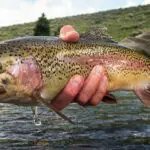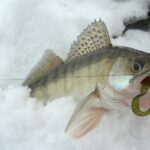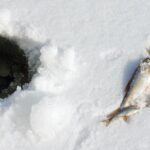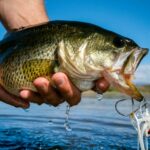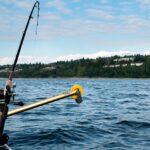Flat-line fishing is a tried and true fishing technique that is very effective when targeting the right fish. There are several methods for fishing a flat line, and it is critical to know how to do it to have the best results.
To fish a flat line, rig your line with a Flatfish lure or another lure that dives and moves naturally in the water. Put your rod in a good rod holder, and use a flat line clip to draw the line away from the rod tip and along the water. Let the line out a few feet, and troll slowly.
Fishing a flat line can be very effective. This fishing technique is growing in popularity, and it has developed a following among fishermen who swear by it. Let’s explore flat line fishing, learn how to do it, the various methods that work well for fishing a flat line, and what makes this technique so effective.
How Do You Fish A Flat Line?
The term ‘flat line’ in fishing has many definitions, and many anglers have a different answer when asked what fishing a flat line is, but the reality is that there is only one true answer definition for flat line fishing.
Fishing a flat line is when a fishing line is let out behind a boat, and trolled at slow speeds, while the line is kept as low to the water as possible, often without bringing the rod low to the water. This rig enables a lure to move through the water more naturally and attract more fish.
This fishing technique has been proven successful for all water types and in almost every region of the world. All that is necessary is a very strong rod, line, and reel, some good techniques, and the right lures.
A standard flat-line fishing setup is to set a rod in a rod holder on a boat. Keep the boat moving slowly. Let the line out with a diving lure attached to it, and allow the lure to drag out a good way. The distance that the line is let out depends on the situation.
The line is then brought directly down from the tip of the rod and held to the handle of the rod, to the exterior of the boat’s hull, or another section on the boat, causing the line to run as flat and close to the water as possible, rather than running from the tip of the rod.
If the line is left to run from the tip of the rod, the lure will be sprung out of the water by the movement of the rod tip. Keeping the line down and flat from the tip keeps the line in the water, allows the lure to move more naturally, and prevents the line from jerking around in the water.
Flat-line clips are designed to let the line free when it is pulled on too hard, indicating a fish on the line. When a fish takes the lure and pulls the line from the clip, it is time to start reeling the fish in.
Set the lure, and reel in your fish. It is best to stop the boat to make the process easier. When you have your fish, reset your rig by casting the lure back into the water, letting it drag out a few dozen feet, setting the line back in the clip, and waiting for the next bite.
There are several techniques to use when flat-line fishing, but this is the basic method used for all types of flat-line fishing, regardless of the location, the water, and the target fish.
Flat Line Fishing Techniques
Flat-line fishing is fun, and it is very effective if you use the right techniques and methods. There are several ways to make flat-line fishing effective and many techniques to try depending on where you are fishing and the fish you are targeting.
Without knowing some of the most effective techniques, flat-line fishing can be difficult to get right. But if you know some good methods, it can give you an advantage from the beginning.
If you have never fished a flat line before, or if you want to improve your flat line fishing success, here are some of the best flat line fishing techniques.
Use A Good Flat Line Clip
There are several types of flat line clips on the market and a few DIY clips that work just as well. It is critical that you investigate the flat line clip that will work best for you and your rig.
Some anglers use a simple piece of bendable wire on their rod handle to clip their line down. Some use a commercial line flip to clip their line to the outside of the boat as close to the water as possible. Some anglers prefer using a clip on an anchor point on the boat.
There are several flat-line clip options to choose from, but it is important to do your own research before getting out on the water to determine which clip will work best for your rig and your boat.
The clip should be strong enough to hold your line down close to the water but not so strong that it will prevent the line from coming up when a fish bites.
The best flat line clips are those with variable pressures to enable you to choose the right clip pressure for your purposes.
Use A Flatfish Lure
There are several lures you can try when fishing a flat line, but the lure that has had the most success with flat line fishing is a Flatfish lure.
These are small, boomerang-shaped lures with tri-hooks attached to them. These lures are available in a vast range of vibrant colorways and in multiple sizes. This means you can choose the lure you use based on the water you are fishing in and the size of the fish you are targeting.
Flatfish lures work well for flat-line fishing because they move very naturally when trolled in the water behind a boat, especially when kept low to the water.
These lures pull themselves deep into the water and shoot up as soon as the boat slows down or slack is added to the line.
Large Flatfish lures will even pull themselves all the way to the waterbed and attract the largest fish, provided you troll them through the right areas.
These lures also vibrate a lot while being dragged, and certain varieties wobble, spin, sway, and drive up and down in the water.
Flatfish lures work exceptionally well for flat-line fishing because they perfectly mimic a small fish or insect moving in the water and move in a very natural way that attracts several fish species.
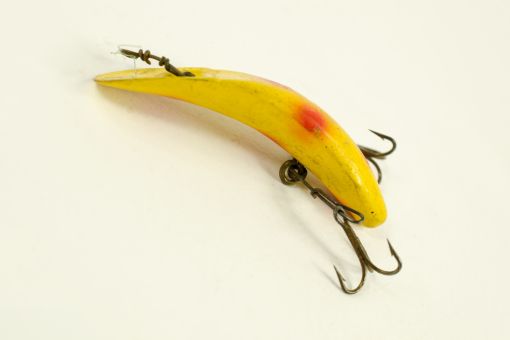
Vary Trolling Speed
While flat line fishing, a good method for hooking more fish is to vary your trolling speed or to pull and lose your line occasionally. This increases the movement of your lure and will pull it in an irregular pattern, which can make it seem more organic.
The more natural the lure looks in the water, the more likely it is to fool a fish into biting it. If you only move the lure at a fixed speed, you are less likely to catch fish, especially if the lure is dragging along the waterbed or sitting near the surface of the water.

Hold The Rod Tip Low
If you do not have a line flip, or if you do not have a rod holder to use for flat line fishing, a basic yet effective method to achieve this technique is to simply hold the tip of your rod close to the water while trolling.
It is important to have another reason with you to control the boat while you do this, to keep the operation as safe as possible.
Hold your rod close to the water while the boat trolls along slowly. This method can be very effective, as it affords the angler significantly more control over the rod and line and allows better control over the movement and speed of the lure.
Holding the rod also increases reaction time, as the angler is more likely to notice when a fish has taken the lure.
This method works very well, despite the lack of fancy equipment and rod holders.
Static Flat Line
Static flat-line is the same as other flat-line techniques, but it is used without moving the boat. This form of flat-lining requires the use of a weighted Flatfish, and the rod is not held in a holder but rather by hand and moved from side to side by hand.
This method is less effective, but it can be useful if you know there are some fish below you and you do not want to move away from where they are. This is a straightforward way to increase your chances of catching fish if you use it at the right time.
Keep A Flat Line In While Bottom Fishing
A common method of maximizing your chances of success while flat-lining is to flat-line fish and bottom fish simultaneously.
Both bottom fishing and flat-line fishing can be used while the boat is trolling slowly. If you use a non-weighted line and a non-weighted lure for the flat line rig, anything that is stirred up by the bottom fishing rig will notice the flat line and take a bite.
Using these fishing techniques in tandem is a highly effective fishing method. Think of it as fishing two levels of the water at the same time. You can leave both rods in holders and toll in the water until something takes a bite.
Using both methods simultaneously double your chances of catching fish, especially in freshwater.
This technique can take some time to set up, and it will require significant trial and error before you completely nail down the methods that work best for you, but you will quickly find that fishing at the top and bottom of the water simultaneously works well.
This is best done if you have another person with you, as the chances are high that you will set a fish on both hooks if you use this technique correctly.
Flat Line With Multiple Rigs
Another good way to catch as many fish as possible while flat-lining is to set up multiple rigs. If your boat has multiple rod holders, try to set a rod and flat-line rig in every holder.
Use lures of different weights, colors, sizes, and hook variations. Try to set the lines at different heights as well.
This method is not to try and catch as many fish as possible at once, but it is a way of quickly finding fish rather than trying all the different lures and line heights one after the other.
Using multiple rigs is a good way to save time while flat-line fishing, provides a way to maximize your chances of finding fish quickly, and will show you what the fish are likely to bite on the day.
Once one of your rigs takes a bite and you get a fish, switch to using that rig for the next few hours, and you will surely catch more.
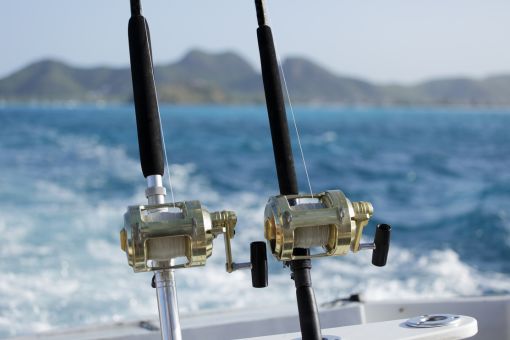
Flat Line With Various Lures
The last tip for flat-lining that we will discuss is using various lures.
Flatfish lures work best for flat-line fishing, but any lures that mimic natural animal movement or natural fish movement in the water are likely to work while flat lie fishing.
The trick is to find a lure that will sit at the right depth according to where you think the fish are. Using the right lure will drastically increase your chances of hooking fish.
Try using various lures until you find a lure that catches something and stick with it for a while. Also, remember to use various colors and sizes of lure. Choose lures with colors that are visible in the water or lures that will cause significant vibrations or light reflections.
Experiment with as many lures as you can until you find one that catches a fish. This will teach you what the fish are looking for, where to find them, and which lures to use for the best results.
Why Does Flat Line Fishing Work So Well?
Flat-line fishing is a highly effective fishing method, especially for fishing in open water such as lakes and the ocean, but why does flat-line fishing work so well?
Flat-line fishing works so well because the method is very good at attracting larger fish, predatory fish, and fish that swim at various depths.
Using flat-line fishing techniques, you can fish all levels of the water, reaching every depth and maximizing your chances of catching fish. You can customize your rig very easily for the fish you are targeting, and you can run multiple rigs simultaneously.
All of this is a recipe for success when fishing. Flat-line fishing does take some skill, and there is some significant trial and error involved, but when you find a method that works well for you, it can be highly effective, and you are likely to get several fish on the line during the fishing day.
Can You Flat Line Fish In Any Water?
Flat-line fishing is effective in open water, such as lakes and the ocean, but can you use these techniques in any water?
You can use flat-line fishing methods in any water; you only need to realize that the tackle and rig you use must be adjusted based on the fish you are trying to catch and the water you are fishing in.
These methods can work well in rivers, streams, lakes, damns, and the ocean, but like any fishing technique, flat line fishing works best when used with the correct gear for the water and the fish.
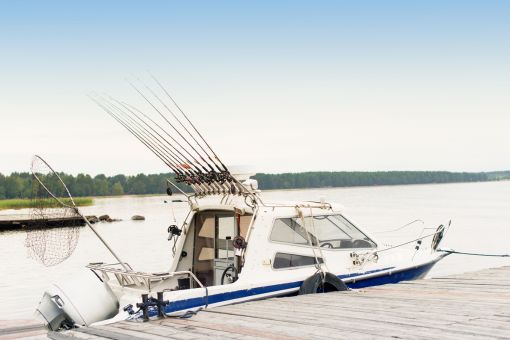
How To Maximize Success When Flat-line Fishing
If you are new to flat-line fishing and are having trouble getting it right, what can you do to maximize success when flat-line fishing?
There are several methods for maximizing your success while flat-line fishing, but the most important aspects of the technique are to use the right lure for the water and the fish you are targeting and stay consistent.
Pay close attention to your rods, keep your lure in the water for as long as possible, keep your boat at a constant speed, look for the fish at every depth, and remain as consistent with your approach as possible.
Use the right sized lures for the target fish, and ensure that the lures are visible in the water you are fishing in. Try baiting the water if necessary, and try adding a bottom fishing rig alongside your floating flat line rig to significantly increase your chances of getting a fish.
Conclusion
Flat-line fishing is very effective and can bring in a lot of fish if you use the techniques well. Take your time on the water, try various methods, and use various lures. When you find the fish, using a flat line makes it eat to catch them.
Fishing a flat line may seem complex initially, but when you learn what works for you, it becomes a standard technique that can be altered to suit any situation or circumstance on the water. Take your time to find the right rig and rhythm for you, and flat-line fishing will become highly effective in no time!
- Do You Need An Indicator For Nymph Fishing? - November 16, 2023
- Fishing Safety Tips For Families - September 25, 2023
- What Is The Best Time To Night Fish At A Lake? - September 18, 2023

